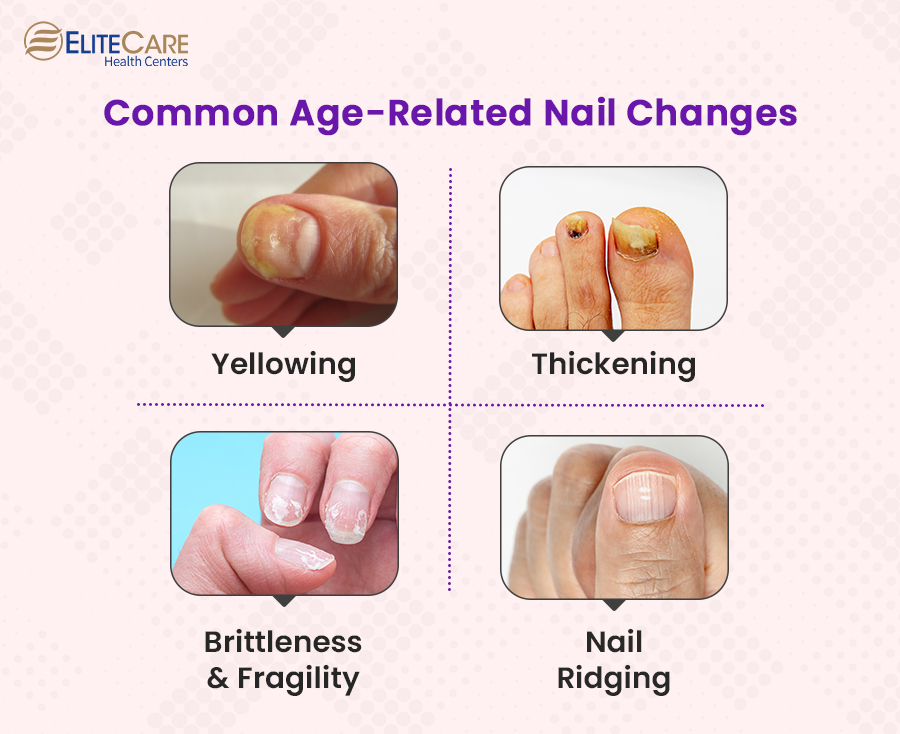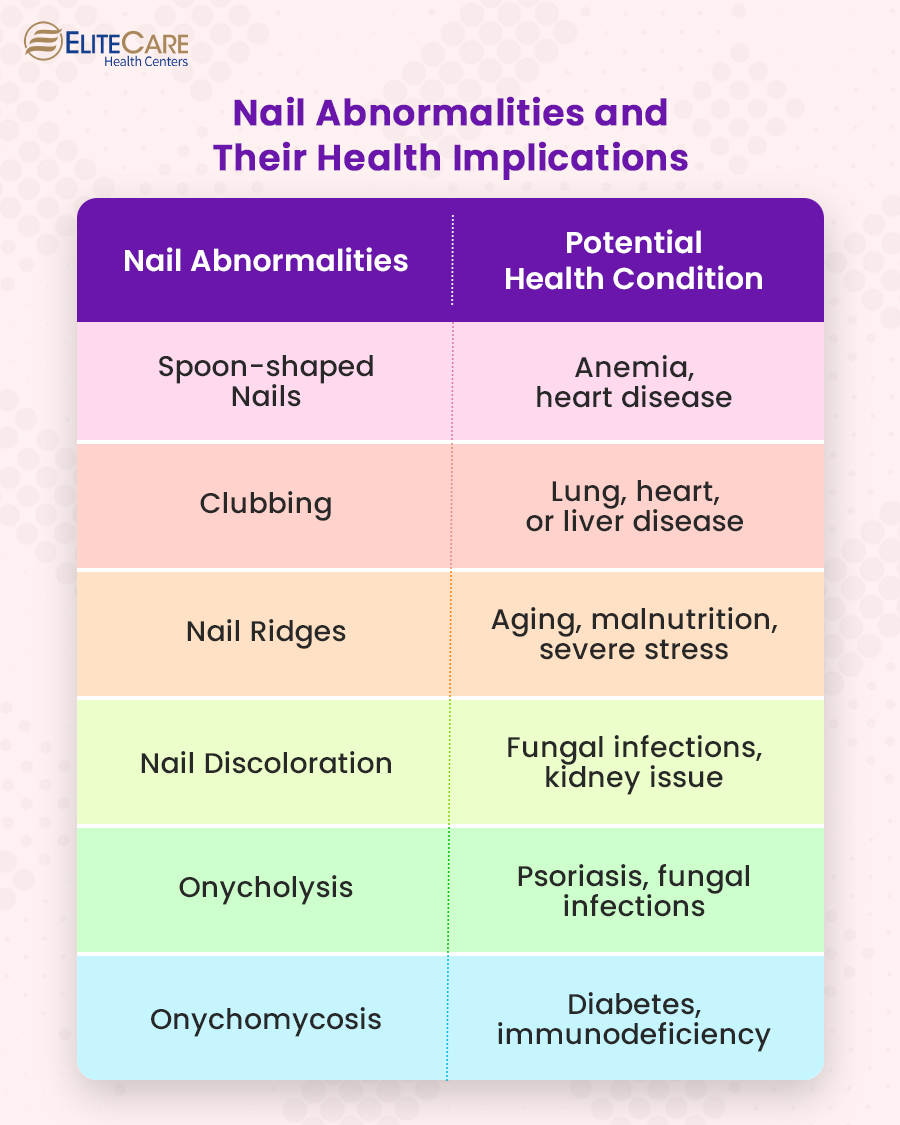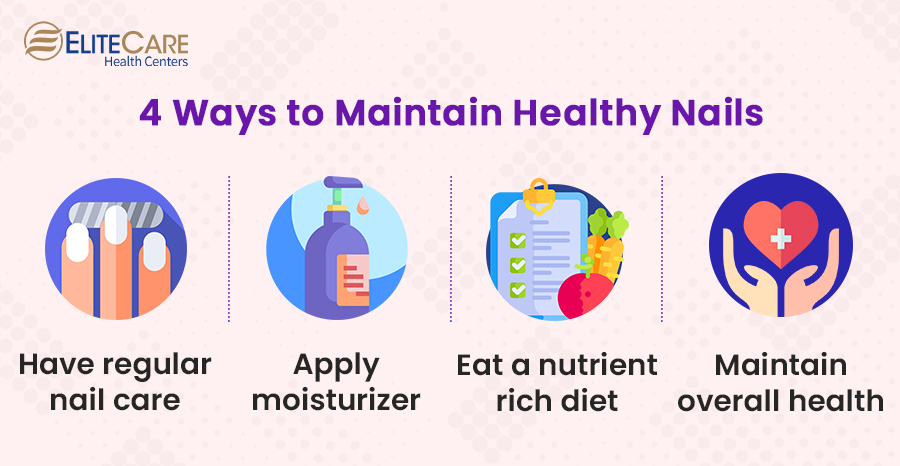
Fingernails are not just for decoration, but they can also be silent messengers, revealing hidden truths about health. With age, the body undergoes various changes, and these transformations can often manifest in unexpected ways. One area that deserves attention regarding seniors’ overall health is their fingernails. The subtle change in nail appearance and texture can provide valuable insights into underlying health conditions such as heart disease, thyroid, and vitamin deficiency. These changes may include yellowing, thickening, brittleness, ridges, and discoloration. In this blog post, we will recognize and address these warning signs, know what proactive steps seniors can take to maintain their well-being and seek appropriate medical advice when necessary.
Factors Influencing Nail Growth
- Age
- Health Conditions
- Nutrition Deficiencies
Common Nail Changes in Seniors

As seniors age, their nails undergo certain changes that are considered normal and age-related. But some changes can serve as indicators of underlying health conditions. The common nail changes observed in seniors and their potential causes are as follows:
1. Yellowing of Nails
One of the most noticeable changes in senior nails is yellowing. The nails may develop a yellow or brownish tint.
Causes: Aging can lead to a natural thickening of the nail plate, giving it a yellowish appearance. Additionally, the use of nail polish, tobacco, and certain medications can contribute to nail discoloration.
2. Thickening of Nails
Seniors often experience thickening of their nails, making them appear more robust and less flexible.
Causes: This change is often attributed to reduced blood flow to the nail bed, affecting the supply of nutrients and oxygen necessary for normal nail growth. As a result, the nail plate thickens over time. The reduced blood flow can also be due to peripheral artery disease or diabetes. Fungal infections, psoriasis, and hypothyroidism can also cause thickening of the nails.
3. Brittleness and Fragility
Senior nails may become brittle, fragile, and prone to cracking or splitting.
Causes: Reduced moisture retention is a common factor contributing to brittle nails in seniors. Nails can become dry and lose their natural oils with age, increasing fragility. Hormonal changes, nutritional deficiencies, and frequent exposure to water and harsh chemicals can worsen this issue.
4. Nail Ridging
Nail ridges, both vertical and horizontal, may become more prominent with age.
Causes: Vertical ridges are typically a natural part of aging and are often harmless.
Other Nail Abnormalities and Their Health Implications

1. Spoon-shaped Nails (Koilonychia)
- Description: Nails with a concave or spoon-like shape.
- Potential Health Conditions: Iron deficiency anemia, heart disease, hypothyroidism.
2. Clubbing
- Description: Enlargement and rounding of the fingertips and nails.
- Potential Health Conditions: Lung diseases (such as chronic obstructive pulmonary disease – COPD), heart diseases, liver diseases, inflammatory bowel disease.
3. Nail Pitting
- Description: Small depressions or pits on the nail surface.
- Potential Health Conditions: Psoriasis, eczema, alopecia areata, connective tissue disorders (such as systemic lupus erythematosus – SLE). Nail psoriasis can greatly impact the quality of life and self-esteem of seniors.
4. Nail Ridges
- Description: Vertical or horizontal lines or ridges on the nails.
- Potential Health Conditions: Aging (vertical ridges), malnutrition, illness, severe stress event (horizontal ridges), rheumatoid arthritis.
5. Nail Discoloration
- Description: Changes in the healthy nail color, including yellowing, whitening, or darkening.
- Potential Health Conditions: Yellowing – fungal infections, smoking, medications; Whitening – liver diseases, kidney diseases, anemia; Darkening – melanoma, subungual hematoma (blood clot under the nail).
6. Onycholysis
- Description: Separation of the nail plate from the nail bed, starting from the tip.
- Potential Health Conditions: Fungal infections, psoriasis, thyroid diseases.
7. Onychomycosis
- Description: Fungal infection of the nails, leading to discoloration, thickening, and brittleness.
- Potential Health Conditions: Diabetes, poor circulation, immunodeficiency, peripheral vascular disease.
These nail abnormalities are not definitive diagnostic criteria but can provide valuable clues for further investigation. Suppose seniors or their caregivers notice any persistent or concerning nail changes. In that case, it’s recommended to consult a healthcare center professional or have an online doctor consultation for proper evaluation and diagnosis.
4 Steps to Maintain Healthy Nails

Essential steps and suggestions for maintaining healthy nails in golden years are as follows:
1. Regular Nail Care
- Trim nails regularly straight across, keeping them at a comfortable length. Use sharp, clean nail clippers or a file designed for nails.
- Keep nails short to minimize the risk of breakage and injury.
- Cuticle care is also important. Push them back with a cuticle stick after a warm bath or shower. Avoid cutting or trimming cuticles excessively to prevent infection or damage.
2. Moisturize and Protect
- Keep nails and cuticles well-moisturized to prevent dryness and brittleness. Apply a nourishing moisturizer or specialized cuticle cream regularly, especially after washing hands.
- Protect nails from harsh chemicals, detergents, and excessive water exposure by wearing gloves while cleaning, gardening, or performing any activity that may expose nails to potential damage.
3. Nutrient-Rich Diet
- Biotin-Rich Foods: Include biotin-rich foods like eggs, nuts, seeds, and whole grains in the diet. Biotin supports nail strength and thickness.
- Consume iron-rich foods (leafy greens, lean meats, legumes) and zinc (oysters, poultry, fortified cereals) to promote healthy nail growth and prevent brittleness.
- Eat various fruits and vegetables to ensure an adequate intake of vitamins A, C, and E. These vitamins contribute to nail health and support the production of healthy nail cells.
4. Maintain Overall Health
- Drink plenty of water to keep the body hydrated.
- Engage in physical activity to improve blood circulation, which supports the delivery of nutrients to the nail matrix.
- If a senior has underlying health conditions like diabetes or thyroid disorders, they should follow their primary care physician‘s guidance to manage them effectively, as these conditions can affect nail health.
- If there is a persistent nail abnormality or a concern about nail health, consider consulting a dermatologist at a healthcare clinic or online consultation for specialized guidance and treatments.
Regular visits to a primary care physician or medical clinic can provide additional guidance and support in maintaining healthy nails. They can assess overall health, identify underlying nail health issues, and provide personalized recommendations.
When to Seek Medical Attention
Nail abnormalities in seniors should never be overlooked. Recognizing the importance of early detection and prompt treatment is essential for seniors. By engaging in open communication with their primary care physician and scheduling regular annual or routine physical exams, seniors can take proactive steps towards maintaining optimal health and addressing any concerns regarding their nail health. Here are some instances when seniors should consult a healthcare professional regarding nail abnormalities:
1. Persistent Changes
If a persistent nail change does not improve or worsen over time, it is important to seek medical attention. This includes changes in color, texture, shape, or thickness that last for several weeks or months.
2. Pain, Inflammation, or Infection
If there is redness, swelling, warmth, or discharge around the nails or cuticles, seek medical attention promptly. As these signs may indicate an underlying infection or inflammatory condition.
3. Sudden Onset of Abnormalities
Rapid changes in the appearance of the nails, such as sudden clubbing, significant nail pitting, or a dramatic change in nail color, should be brought to the healthcare provider’s attention.
4. Regular Annual or Routine Physical Exams
Having annual or routine physical exams with a healthcare provider at our medical clinic is an excellent way to monitor one’s overall health. Seniors can discuss any concerns or changes they have noticed during these exams with their nails. The healthcare provider can provide guidance, perform a thorough examination, and order further tests if needed.
To Sum Up
Quality of seniors’ fingernails are important health indicators. It is also important to adopt consistent good nail care practices and maintaining a well-balanced diet should be integral to seniors’ overall health and well-being routine. Connect with the primary care physicians at Elite Care Health Centers for comprehensive and individual care.
They can provide valuable clues about seniors’ overall health. By paying attention to nail health, seniors can proactively manage their well-being and address potential health issues promptly. Our team of professionals is dedicated to supporting seniors on their health journey and ensuring their nail health is given the attention it deserves.
Let’s take charge of our health and enjoy vibrant, strong, beautiful nails that reflect inner vitality.






